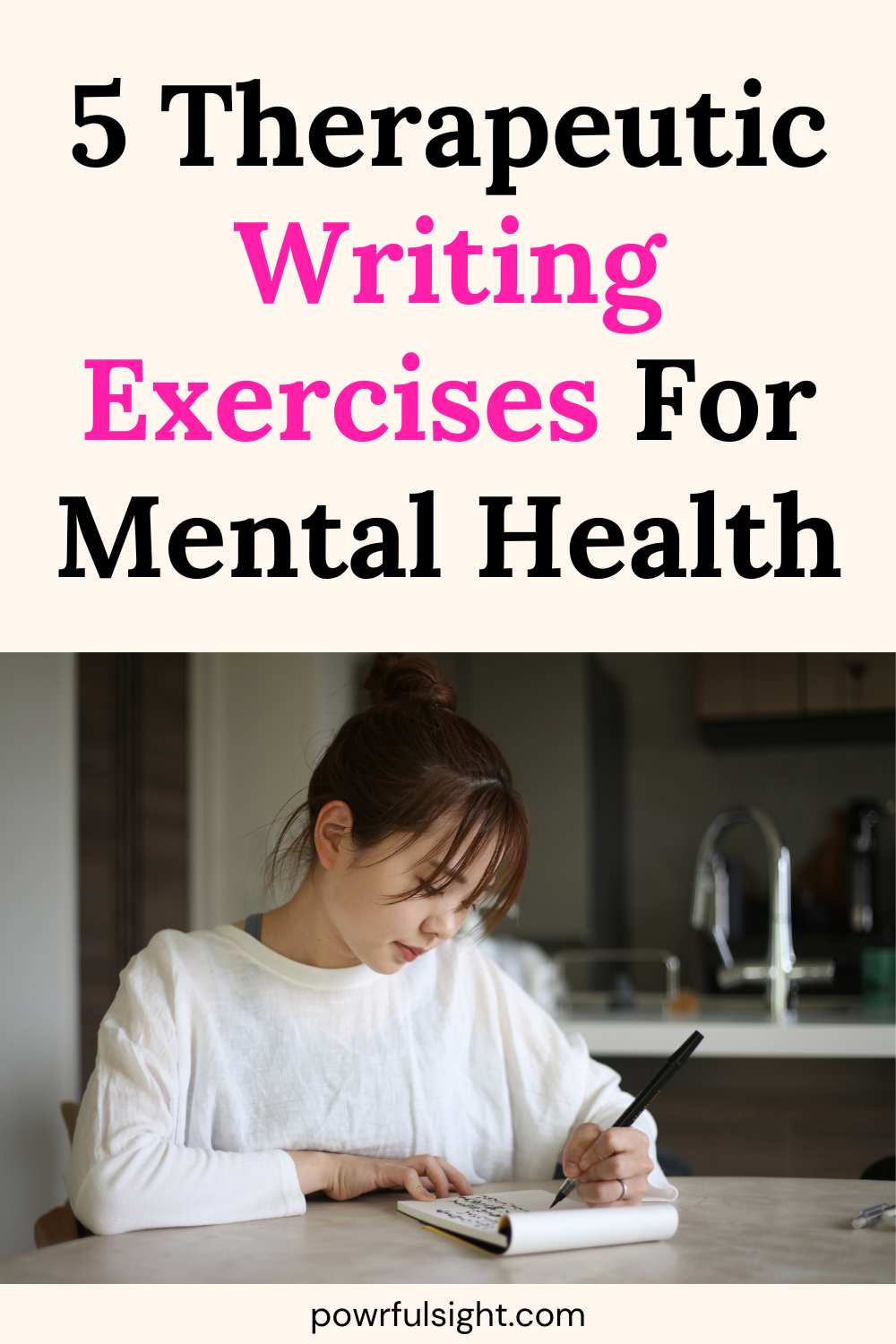Mental health is just as important as physical health, but it often gets pushed aside. Our world is full of stressful events and fast-paced living, making life more challenging than ever.
It’s no wonder we all need to focus on taking care of our emotional well-being. There are many tools to help you do that, and one of the easiest and most accessible methods is writing.
Therapeutic writing practices are easy to learn, free and can provide benefits for mental health as a supplemental form of treatment to help you manage stress, anxiety, depression, and intense emotions.
5 Therapeutic Writing Exercises For Mental Health
1. Journaling for Emotional Release
Journaling is one of the most basic therapeutic writing exercises but also one of the most effective. It provides a safe space for you to vent, reflect, and process any complex emotions you might have. Writing things down externalizes your thoughts and feelings so you can manage them better.
Why It Works:
Journaling helps to clear mental clutter, giving you a chance to process your thoughts and emotions. It allows you to vent any frustrations, work through difficult emotions, and reflect on your inner world without judgment. Journaling can reduce the impact of stress and the feeling of being overwhelmed by providing a safe place to release built-up emotions.
Related: 50 Mindful Micro Rituals To Start
How to Practice Journaling for Emotional Release:
-
Set a routine: Choose a time of day where you can journal regularly. This could be first thing in the morning or right before bed. Try to set aside at least 10-20 minutes a day for your journaling practice.
-
Write freely: Don’t worry about grammar, spelling, or structure. Just write whatever comes to mind and don’t judge yourself for what you’re writing. Let your thoughts and emotions flow freely.
-
Be honest: Write how you feel without censoring or filtering your thoughts. Whether you’re angry, sad, confused, or stressed, just let it all out on paper.
-
Reflect on patterns: After a few weeks of journaling, go back and read your entries. Look for any themes, thoughts, or emotions that repeat. This can help you identify triggers and areas you can work on.
Benefits:
-
Emotional release and stress relief
-
Increased self-awareness
-
Ability to track emotional patterns over time
-
Promotes self-reflection and understanding
-
Encourages emotional resilience
Related: How To Start A Journal: Step By Step Guide For Beginners
2. Gratitude Journaling
Writing down things you are grateful for each day is another simple but effective writing exercise. This practice is all about training your brain to focus on the positive aspects of your life, rather than dwelling on negative emotions or things that are stressing you out.
Why It Works:
Scientifically, gratitude has been proven to reduce symptoms of depression and anxiety, increase overall happiness and feelings of well-being, and promote positive thinking. Gratitude trains your brain to see the good in life, which helps improve your emotional well-being and perspective.
Related: 40 Gratitude Quotes To Show Appreciation
How to Practice Gratitude Journaling:
-
Begin with three: Each day, try to write at least three things you’re grateful for. This could be as simple as a warm cup of tea or a larger event such as receiving an unexpected compliment.
-
Be specific: Don’t be vague with your gratitude writing; get specific. If you’re writing that you’re grateful for your family, be more specific. For example, “I am grateful for the amazing dinner my sister made for me today.”
-
Reflect on the gratitude: Get in the habit of not just listing things you’re grateful for, but reflecting on why and how they made you feel.
-
Write daily: Try to write in your gratitude journal every day, either in the morning or before bed, as part of your routine.
Benefits:
-
Reduces anxiety and depression
-
Improves overall mood and emotional well-being
-
Helps shift focus to the positive
-
Increases feelings of fulfillment and satisfaction
-
Encourages resilience during tough times

3. Writing Letters to Yourself
Writing letters to yourself is a therapeutic exercise where you practice writing love, compassion, and understanding. This can be a powerful way to give yourself comfort during a rough time or process past trauma or mistakes.
Why It Works:
This exercise helps you practice self-compassion and introspection. Writing to yourself provides an opportunity to reassure, understand, and support yourself. Letters to yourself are especially helpful when processing difficult emotions like guilt, regret, or low self-esteem, allowing you to give yourself the empathy and love you need.
How to Practice Writing Letters to Yourself:
-
Past letter: Think of a time in your life when you felt particularly stressed out, hurt, or uncertain. Write a letter to that version of yourself, offering reassurance, support, and compassion. Remind your past self that they are doing the best they can and are worthy of love and forgiveness.
-
Future letter: Write a letter to your future self, the person you’re working to become. Offer encouragement and advice and remind your future self that they are strong and capable of facing whatever life brings.
-
Be kind and gentle: In this exercise, talk to yourself with kindness and understanding. Don’t be critical or judgmental; instead, promote healing and growth.
-
Read and reflect: After writing, read the letter and reflect on what you wrote. Use this as a reminder of your strengths and potential.
Benefits:
-
Self-compassion and healing
-
Helps reduce guilt or regret
-
Builds self-awareness and personal growth
-
Provides clarity and closure
-
Builds positive self-esteem and acceptance
Related; 8 Daily Habits For Mental Wellness
4. Affirmations for Positive Mental Health
Affirmations are positive statements used to replace negative thought patterns and create an empowered mindset. Writing and repeating affirmations is an excellent way to rewire your brain to focus on your strengths, capabilities, and potential.
Why It Works:
Writing affirmations combats negative self-talk and boosts confidence. When you affirm positive things about yourself and your life, you lay the foundation for self-love and resilience. This exercise is especially helpful for stress and overall mental health.
How to Practice Affirmations:
-
Write daily affirmations: Choose a few positive affirmations to write each day. These could be statements about your worth, your capabilities, or your future goals. Example: “I am worthy of love and happiness” or “I have the strength to overcome any challenge.”
-
Present tense: Write affirmations in the present tense as if they are already true. Example, instead of saying, “I will be successful,” write, “I am successful.”
-
Believe them: As you write your affirmations, try to truly believe what you’re writing. Picture yourself actually embodying the positive qualities and characteristics you’re affirming.
-
Repeat, repeat, repeat: Read your affirmations aloud every day and repeat them as often as you need a confidence boost. The more you say them, the better they will work in changing your mindset.
Benefits:
-
Increases self-esteem and self-worth
-
Reduces negative thinking and anxiety
-
Promotes positive thinking and empowerment
-
Builds emotional resilience
-
Strengthens emotional well-being and confidence
Related: 150 Affirmations To Love Your Body
5. Creative Writing for Emotional Expression
Creative writing, like poetry or short stories, is an excellent way to process emotions that you might find hard to directly express. Creative writing can provide an outlet to indirectly express your emotions and is a great way to work through difficult feelings.
Why It Works:
Creative writing provides a safe space to process emotions. It allows for emotional expression in a less direct way, which might feel overwhelming at first. For example, you could write about a character experiencing similar emotions to those you’re feeling, using fiction to externalize and better understand your emotions. It also helps you be more mindful and reflective as you work through different aspects of your emotions through creative writing.
How to Practice Creative Writing:
-
Write about your emotions: Start a short story or poem that represents how you’re feeling. Use metaphors, imagery, or characters to express your emotions in a less direct way.
-
Create a fictional world: Let your imagination run wild and write about a fictional world where you can safely process your emotions.
-
Reflect on your writing: After finishing a piece, take time to read it over. What emotions come up for you? What did you learn about yourself? Use creative writing to help you understand and process complex emotions.
Benefits:
-
Provides a safe place for emotional expression
-
Helps process complex emotions
-
Increases self-reflection and emotional understanding
-
Enhances creativity and problem-solving
-
Provides relief and catharsis
Conclusion
Writing can be a very powerful tool that most people have access to right at their fingertips. Whether you are struggling with stress, anxiety, or depression, these therapeutic writing exercises are here to help.
Try adding one or more of these into your daily or weekly routine to improve your mental health. Each exercise offers a safe space to express yourself, understand your emotions, and build emotional resilience.
Save the pin for later

- 200 Truth Or Dare Questions For Your Crush - 09/12/2025
- 13 Signs He Will Never Forget You - 09/12/2025
- 8 Signs You’re Still Emotionally Attached To Your Ex - 09/12/2025